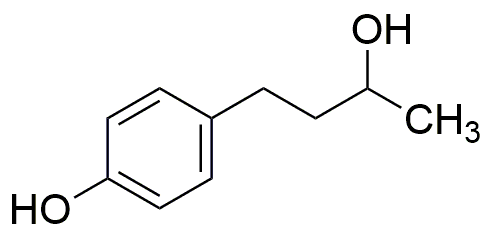Rhododendrol is widely utilized in research focused on:
- Cosmetic Formulations: This compound is often used in skincare products for its skin-lightening properties, making it popular in formulations aimed at reducing hyperpigmentation.
- Pharmaceutical Applications: Rhododendrol has potential therapeutic effects, particularly in dermatology, where it may be explored for treating skin disorders due to its anti-inflammatory properties.
- Research on Melanogenesis: It serves as a valuable tool in studies investigating the mechanisms of melanin production, helping researchers understand pigmentation processes and develop targeted treatments.
- Industrial Applications: The compound is also explored in the production of dyes and pigments, providing vibrant colors in various materials, including textiles and plastics.
- Antioxidant Research: Rhododendrol is being studied for its antioxidant capabilities, which could lead to applications in food preservation and health supplements aimed at combating oxidative stress.
Informations générales
Propriétés
Sécurité et réglementation
Applications
Rhododendrol is widely utilized in research focused on:
- Cosmetic Formulations: This compound is often used in skincare products for its skin-lightening properties, making it popular in formulations aimed at reducing hyperpigmentation.
- Pharmaceutical Applications: Rhododendrol has potential therapeutic effects, particularly in dermatology, where it may be explored for treating skin disorders due to its anti-inflammatory properties.
- Research on Melanogenesis: It serves as a valuable tool in studies investigating the mechanisms of melanin production, helping researchers understand pigmentation processes and develop targeted treatments.
- Industrial Applications: The compound is also explored in the production of dyes and pigments, providing vibrant colors in various materials, including textiles and plastics.
- Antioxidant Research: Rhododendrol is being studied for its antioxidant capabilities, which could lead to applications in food preservation and health supplements aimed at combating oxidative stress.
Documents
Fiches de données de sécurité (FDS)
La FDS fournit des informations de sécurité complètes sur la manipulation, le stockage et l’élimination du produit.
Spécifications du produit (PS)
Le PS fournit une description complète des propriétés du produit, notamment sa composition chimique, son état physique, sa pureté et les exigences de stockage. Il détaille également les plages de qualité acceptables et les applications prévues du produit.
Certificats d'analyse (COA)
Recherchez des certificats d'analyse (COA) en saisissant le numéro de lot du produit. Les numéros de lot et de lot se trouvent sur l'étiquette d'un produit, après les mots « Lot » ou « Lot de fabrication ».
Numéro de catalogue
Numéro de lot/série
Certificats d'origine (COO)
Ce certificat d'exploitation confirme le pays dans lequel le produit a été fabriqué, et détaille également les matériaux et composants utilisés et s'il est issu de sources naturelles, synthétiques ou autres sources spécifiques. Ce certificat peut être requis pour les douanes, le commerce et la conformité réglementaire.
Numéro de catalogue
Numéro de lot/série
Fiches de données de sécurité (FDS)
La FDS fournit des informations de sécurité complètes sur la manipulation, le stockage et l’élimination du produit.
DownloadSpécifications du produit (PS)
Le PS fournit une description complète des propriétés du produit, notamment sa composition chimique, son état physique, sa pureté et les exigences de stockage. Il détaille également les plages de qualité acceptables et les applications prévues du produit.
DownloadCertificats d'analyse (COA)
Recherchez des certificats d'analyse (COA) en saisissant le numéro de lot du produit. Les numéros de lot et de lot se trouvent sur l'étiquette d'un produit, après les mots « Lot » ou « Lot de fabrication ».
Numéro de catalogue
Numéro de lot/série
Certificats d'origine (COO)
Ce certificat d'exploitation confirme le pays dans lequel le produit a été fabriqué, et détaille également les matériaux et composants utilisés et s'il est issu de sources naturelles, synthétiques ou autres sources spécifiques. Ce certificat peut être requis pour les douanes, le commerce et la conformité réglementaire.


